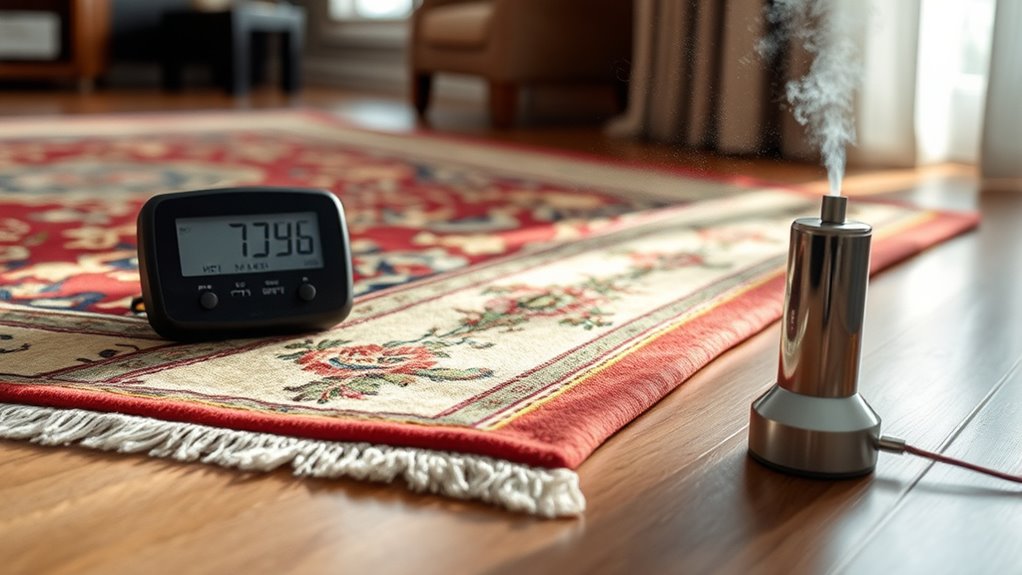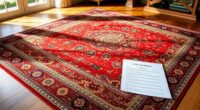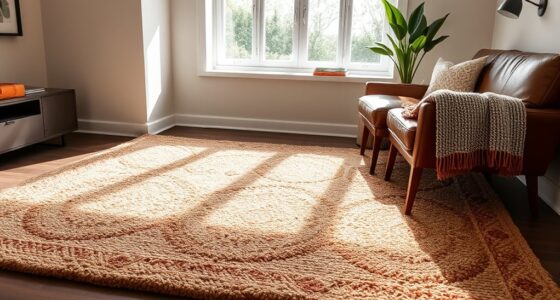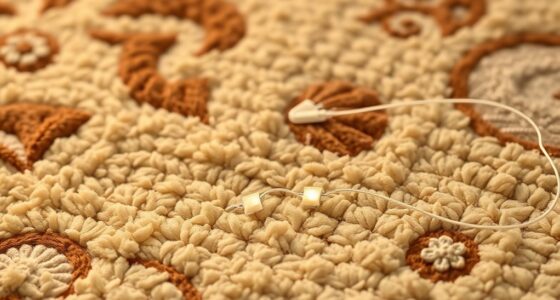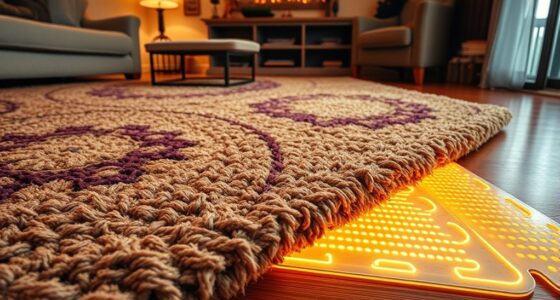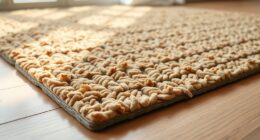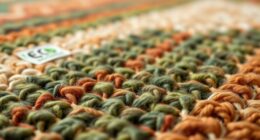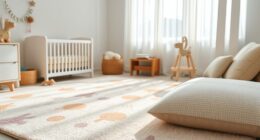To prevent rug dry-rot, keep indoor humidity levels between 30-50% using dehumidifiers, vents, or natural airflow. Regularly monitor moisture with reliable hygrometers and adjust settings or airflow accordingly. Guarantee proper placement of rugs, avoid excess moisture from leaks or spills, and promote good ventilation through fans and open windows. Staying vigilant with maintenance helps protect your rugs long-term. If you want to learn more about controlling humidity effectively, continue exploring these tips.
Key Takeaways
- Maintain indoor humidity between 40-50% to prevent excess moisture that causes dry-rot.
- Use dehumidifiers properly positioned in central areas to control humidity levels consistently.
- Ensure good ventilation by opening windows, using exhaust fans, and promoting cross-ventilation.
- Regularly monitor humidity with reliable hygrometers, calibrate sensors, and adjust devices as needed.
- Repair leaks, address dampness promptly, and eliminate sources of excess moisture to protect rugs from dry-rot.
Understanding the Impact of Humidity on Rug Health
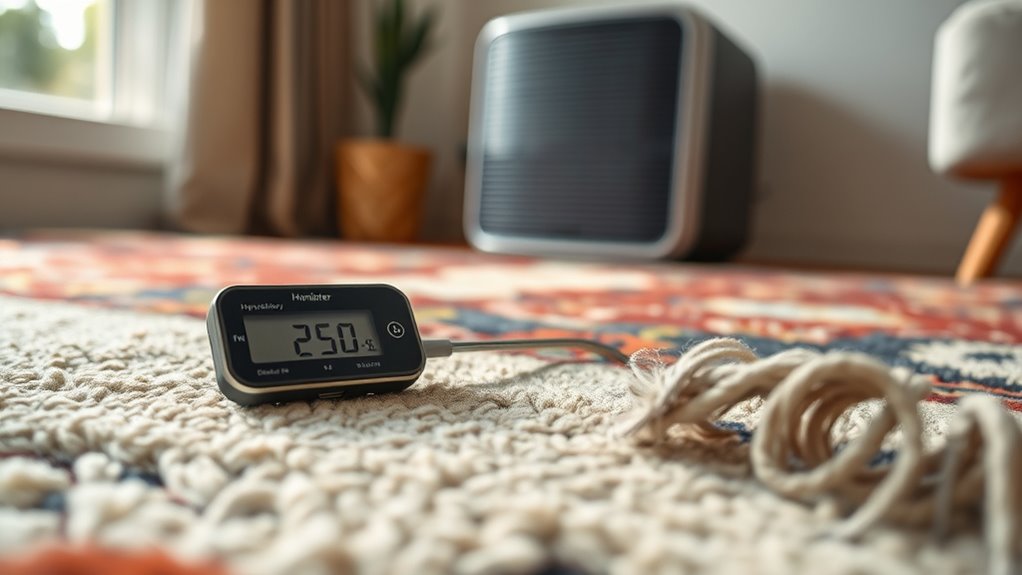
Humidity levels directly affect the condition of your rugs. When humidity is too high, it creates an ideal environment for mold prevention issues, which can damage your rugs and compromise air quality. Excess moisture promotes mold growth, leading to stains, unpleasant odors, and potential health hazards. Maintaining suitable humidity helps prevent these problems, ensuring your rugs stay clean and durable. You should monitor indoor humidity regularly and keep it within a healthy range, ideally between 30-50%. Proper humidity control not only extends the life of your rugs but also improves overall air quality in your home. Investing in an air purifier with advanced filtration technology can further help reduce allergens and maintain a healthier indoor environment. Additionally, controlling humidity levels can prevent dry rot and other moisture-related damages to your flooring and furnishings. Understanding home maintenance practices can also help you allocate funds towards necessary home maintenance devices, ensuring long-term protection. Implementing innovative AI technology in home systems can optimize humidity control more precisely, leading to better protection for your belongings. By managing humidity effectively, you reduce the risk of mold development, protect your investment, and create a healthier living environment for yourself and your family.
Monitoring Indoor Humidity Levels Effectively

To keep your indoor environment comfortable and protected, you need to monitor humidity levels accurately. Use a reliable hygrometer to measure your space’s humidity, ensuring it stays within the ideal range. Consistently checking and adjusting helps you maintain steady levels and prevent issues caused by fluctuations. Regular maintenance and calibration of your hygrometer ensure ongoing accuracy and effective air quality monitoring. Incorporating field recording techniques can help you interpret humidity patterns more effectively, leading to better control and prevention of rug dry-rot. Staying informed about AI safety measures can also contribute to maintaining a secure environment for your household. Additionally, understanding the optimal angles for pinball machines can enhance your recreational space, creating a balanced environment that promotes both comfort and enjoyment.
Optimal Humidity Range
Have you ever wondered what the ideal indoor humidity level is for comfort and health? In a humid climate, maintaining the right range prevents excess moisture absorption by your rug, reducing the risk of dry‑rot. The optimal humidity typically falls between 30% and 50%. Staying within this range helps your home feel comfortable and minimizes mold growth. Too low, and your rug and furniture may become brittle; too high, and moisture problems can arise. Use this table to guide your understanding:
| Humidity Level | Effect |
|---|---|
| 30-50% | Ideal for comfort and moisture control |
| Below 30% | Increased risk of dry‑rot and cracking |
| Above 50% | Excess moisture, mold, and mildew |
| Humid Climate | Requires vigilant monitoring |
Maintaining proper humidity levels is essential for protecting your home environment and preventing issues like dry‑rot. Keeping humidity in this range is key to avoiding rug dry‑rot and maintaining a healthy home. Proper humidity management can help prevent issues caused by fluctuating moisture levels.
Using Hygrometers Properly
Using a hygrometer effectively is essential for maintaining the ideal indoor humidity levels that promote comfort and prevent moisture problems like rug dry‑rot. To get accurate readings, place the hygrometer in a central location away from direct sunlight, drafts, or heat sources. Regularly check the device, especially after rug cleaning, to confirm humidity stays within the recommended range. When selecting rugs, consider material types that respond well to humidity fluctuations, such as natural fibers like wool or cotton. Proper use of a hygrometer helps you monitor moisture levels precisely, so you can take timely action if levels rise or fall outside the optimal range. Additionally, understanding industry trends can help you stay informed about best practices for humidity control. Ensuring proper air circulation around your rugs can also prevent moisture buildup and mold growth. Incorporating smart humidity monitors can further enhance your ability to maintain stable indoor conditions. Maintaining proper ventilation is crucial for controlling humidity and preventing issues like dry‑rot, especially in enclosed spaces. Using appropriate humidifiers and dehumidifiers can help you maintain consistent moisture levels and protect your rugs from damage. This proactive approach ensures your rugs stay dry and healthy, prolonging their lifespan and maintaining indoor air quality.
Maintaining Consistent Levels
Consistently monitoring indoor humidity levels helps prevent problems like mold growth and structural damage, guaranteeing your home stays comfortable and healthy. Using humidity sensors, you can track moisture levels accurately throughout the day. When humidity rises too high, your air conditioning system can help reduce the excess moisture, maintaining a stable environment. Set your sensors to alert you when levels fluctuate outside your desired range, so you can take immediate action. Regularly checking these sensors ensures consistent readings and effective control. Understanding the importance of air quality and proper humidity management can significantly enhance your home’s safety and comfort. By integrating air conditioning and humidity sensors into your routine, you’ll keep humidity levels steady, protecting your home from dry-rot and other humidity-related issues. This proactive approach helps create a safe, comfortable living space with minimal effort.
Using Dehumidifiers to Maintain Optimal Conditions
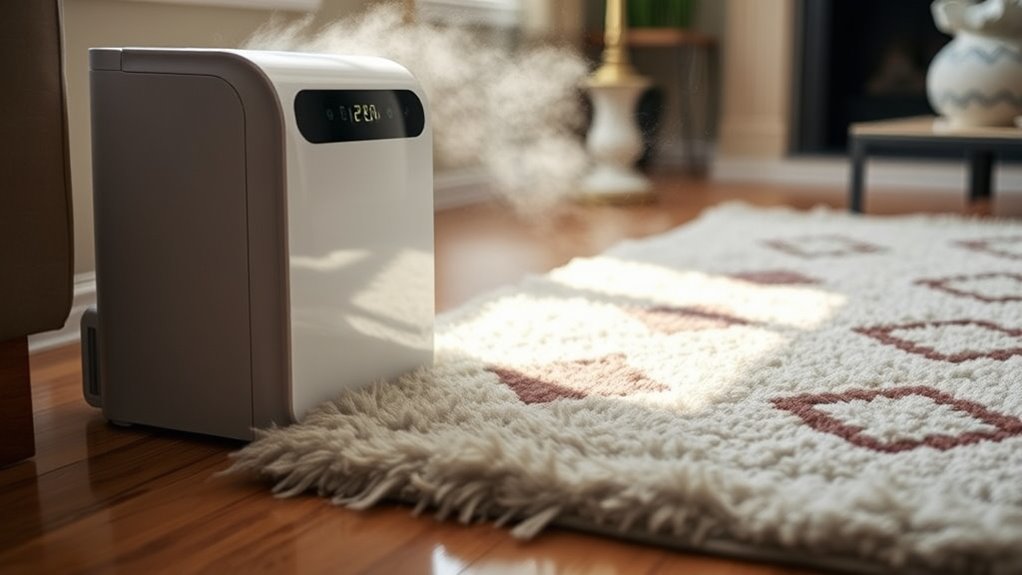
To keep your indoor environment comfortable, proper dehumidifier placement is essential. You should aim for a humidity level between 30% and 50%, and regularly check and maintain your unit for ideal performance. With the right setup and routine monitoring, you can effectively control moisture and prevent issues caused by excess humidity.
Dehumidifier Placement Tips
Proper placement of your dehumidifier is key to effectively controlling humidity levels. Position it in central locations of the room, away from walls and furniture, to guarantee even air circulation. This placement helps prevent excess moisture from settling on your rug, reducing the need for frequent rug cleaning caused by mold or mildew. If you have decorative layering on your floors, place the dehumidifier where it won’t disturb these elements, preserving their appearance. Avoid corners or tight spaces, as airflow is restricted there. Keep the unit elevated on a sturdy surface, allowing air to flow freely underneath. Regularly check the unit’s intake and exhaust vents for obstructions to maximize efficiency. Correct placement ensures your dehumidifier maintains ideal humidity, protecting your rugs and enhancing their longevity.
Optimal Humidity Levels
Have you ever wondered what the ideal humidity level is for your home? Maintaining a humidity level between 40% and 50% is key to preventing rug dry‑rot and mold growth. Using a dehumidifier helps you achieve this balance, promoting air purification by reducing excess moisture that fosters mold. When humidity gets too high, mold spores thrive, risking damage to your rugs and promoting unhealthy air quality. Keeping humidity within the suitable range inhibits mold development and supports a cleaner, healthier environment. Regularly adjusting your dehumidifier ensures consistent conditions, preventing dampness that can lead to dry‑rot. By controlling humidity levels effectively, you protect your rugs and improve air quality, creating a safer, more comfortable home.
Monitoring and Maintenance
Regularly monitoring your dehumidifier guarantees it’s working effectively to keep humidity levels in the ideal range. Check the device’s settings and empty the water reservoir frequently to guarantee continuous operation. Proper humidifier maintenance prevents dust buildup and mechanical issues, extending its lifespan and efficiency. Keep an eye on the humidity gauge to adjust settings as needed, avoiding excessive dryness or dampness. Incorporate mold prevention techniques by cleaning filters and surfaces regularly, reducing mold spores that thrive in high-humidity environments. Consistent maintenance also helps identify potential problems early, saving you from costly repairs. By staying proactive, you ensure your dehumidifier maintains optimal conditions, protecting your rugs and home from dry-rotting and mold growth.
Improving Ventilation in Your Living Spaces
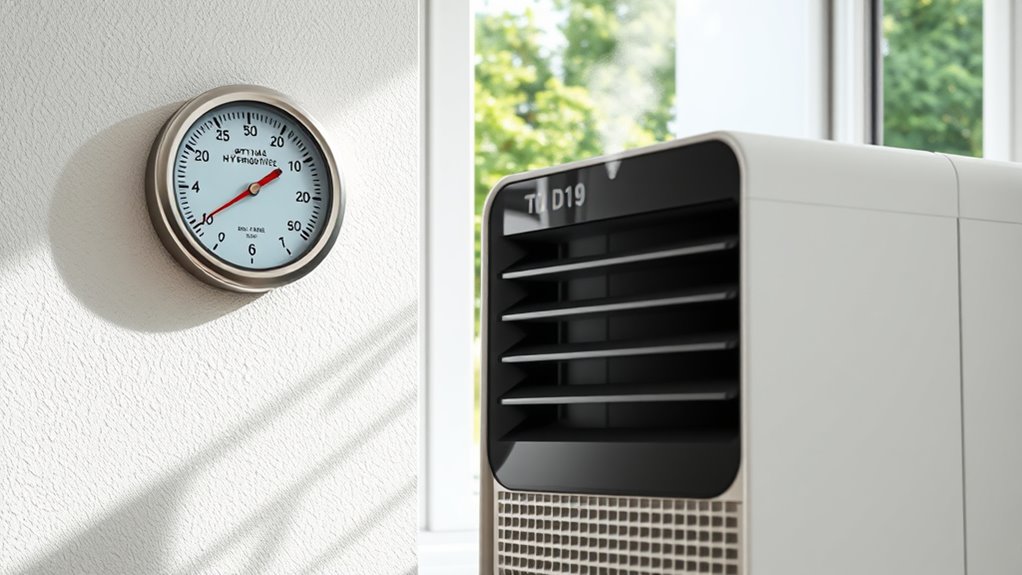
To effectively improve ventilation in your living spaces, you need to guarantee fresh air circulates freely and stale air is replaced. Regular humidifier maintenance ensures your device functions properly, preventing excess moisture that can lead to mold growth. Use exhaust fans in bathrooms and kitchens to vent humid air outdoors, reducing indoor humidity levels. Open windows whenever possible to allow cross-ventilation, especially on days with lower outdoor humidity. Keep air vents unobstructed and consider installing air exchangers for continuous airflow. Proper ventilation reduces stagnant air and helps control humidity, which is vital for mold prevention. By maintaining your humidifier and promoting good airflow, you create a healthier environment that protects your rugs and prevents dry-rot.
Managing Sources of Excess Moisture
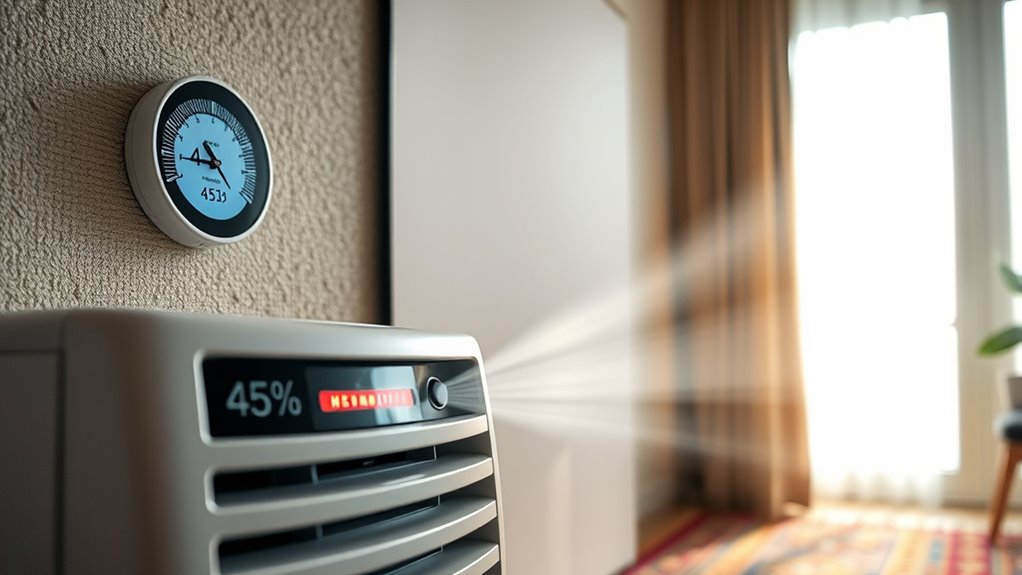
Managing sources of excess moisture starts with identifying activities and conditions that introduce humidity into your home. Cooking, laundry, and even showering add moisture to the air, impacting air quality and creating a humid environment. To control this, use exhaust fans or open windows during these activities. Leaking pipes or damp basements also increase moisture levels, so promptly repair leaks and improve drainage. High humidity can attract pests like silverfish and mold, which thrive in moist conditions. Regularly inspecting and sealing cracks helps reduce pest entry points and keeps moisture out. By managing these sources, you minimize excess humidity, helping to prevent rug dry-rot and maintain a healthier living environment.
Proper Placement and Care of Rugs to Minimize Moisture
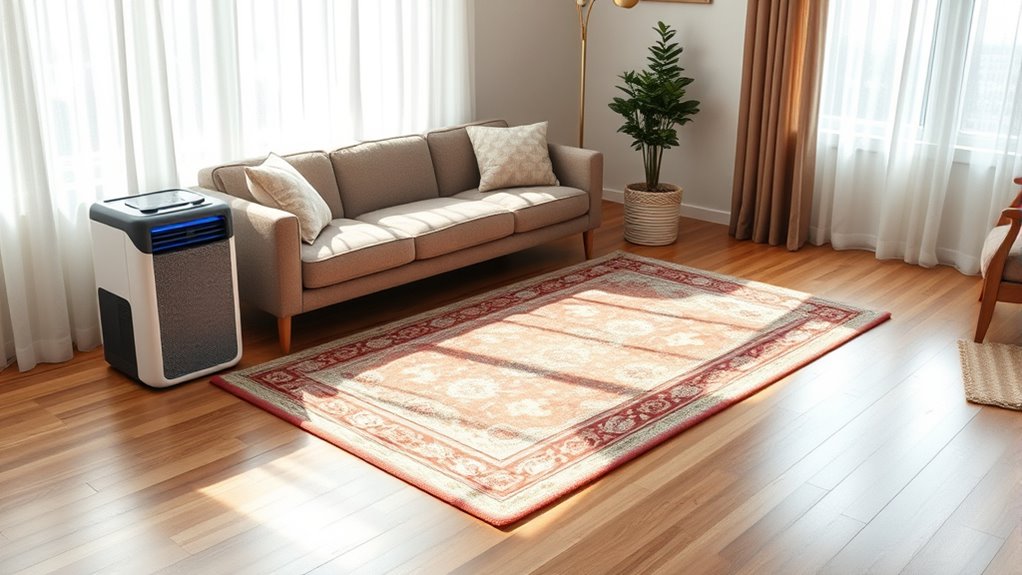
Proper placement and care of rugs play a vital role in controlling indoor humidity levels. To prevent moisture buildup, choose rugs made from breathable materials like wool or cotton, which help regulate moisture. Avoid placing rugs directly on cold, damp floors; use a rug pad to promote airflow and reduce trapped moisture. Regularly inspect and clean your rugs to prevent pest infestations, which thrive in humid environments. Keep rugs dry and avoid excessive watering or spills that can seep into the material. Properly ventilate the space and avoid placing rugs in areas prone to moisture, such as basements or bathrooms.
- Use breathable rug materials like wool or cotton
- Elevate rugs slightly with a pad for airflow
- Regularly clean to prevent pests and moisture buildup
Employing Natural Humidity Control Methods
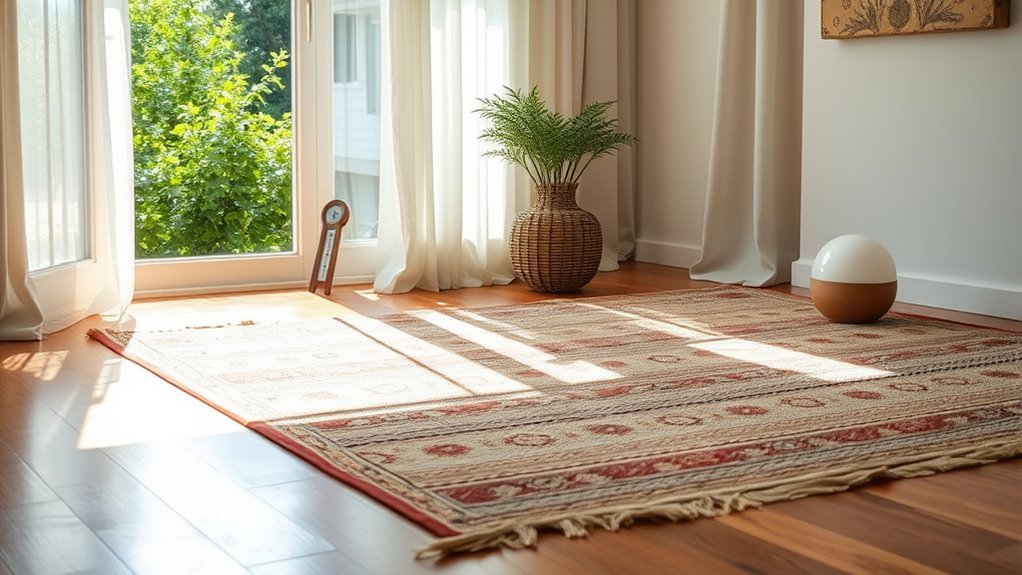
Employing natural humidity control methods offers an effective way to maintain comfortable indoor air without relying on electronic devices. You can create DIY moisture barriers using simple materials like plastic sheeting or natural fabrics to prevent excess moisture from seeping into your rug area. Additionally, using natural desiccants such as silica gel, activated charcoal, or even homemade options like dried rice or oats helps absorb excess humidity. Place these desiccants in containers near rugs or in affected spaces to keep moisture levels balanced. These methods are affordable, eco-friendly, and easy to implement, making them ideal for maintaining a dry environment. By actively managing humidity with natural solutions, you reduce the risk of dry-rot and preserve your rugs’ integrity over time.
Regular Inspection and Maintenance of Rugs and Surroundings
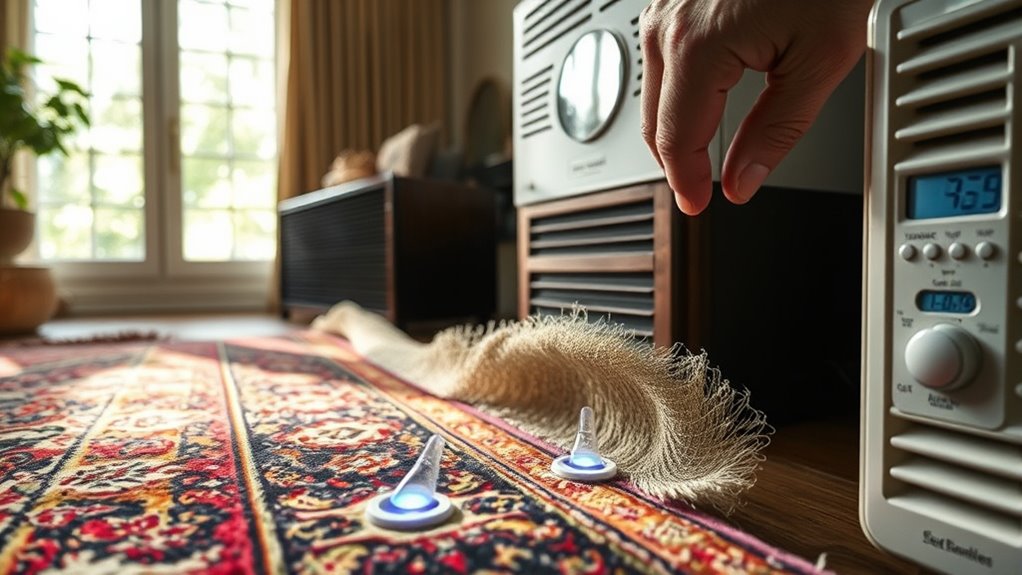
Regularly inspecting your rugs and surrounding areas helps catch moisture problems early before they cause damage. Check for signs of dampness, mold, or odors that indicate excess humidity. Pay special attention to rug padding, as it can trap moisture and promote rot if unchecked. Prompt stain removal is essential; lingering stains can harbor mold or bacteria, exacerbating humidity issues. Make certain your rugs are well-ventilated and lift them periodically to inspect the underside and the flooring beneath. Keep the area clean and dry to prevent mold growth. Consider using a moisture meter to monitor humidity levels around your rugs. Regular maintenance not only extends the life of your rugs but also helps maintain a healthier indoor environment. Consistency is key to preventing dry-rot and preserving your home’s comfort.
When to Seek Professional Assistance for Humidity Issues
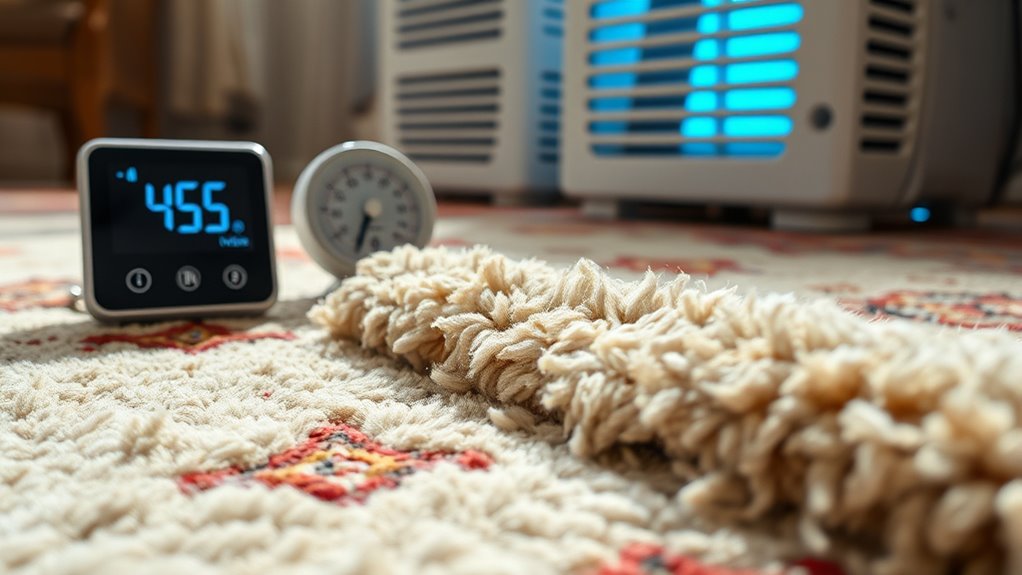
If you notice persistent musty odors, visible mold growth, or recurring dampness despite your efforts to control humidity, it’s time to seek professional help. A professional evaluation can identify underlying issues causing excess moisture, preventing further damage. Professionals can perform thorough moisture remediation, addressing hidden sources of humidity that DIY methods may overlook. Recognizing when to call in experts ensures your rug and home remain protected. Consider the following indicators:
| Issue | Action Needed | Benefits |
|---|---|---|
| Ongoing mold or dampness | Hire a professional for evaluation | Long-term moisture control |
| Unexplained musty smell | Seek moisture remediation services | Prevent dry-rot and damage |
| Visible mold despite cleaning | Professional assessment and remediation | Safeguard your investment |
Timely professional intervention saves you future costs and preserves your home’s integrity.
Frequently Asked Questions
Can Certain Rug Materials Resist Dry-Rot Better Than Others?
You wonder if some rug materials resist dry-rot better than others. Generally, materials with high durability, like wool or synthetic fibers, are more resistant and help with rug preservation. Natural fibers such as cotton may be less durable and prone to damage from moisture. Choosing rugs made from durable materials can substantially extend their lifespan and prevent dry-rot, especially in humid environments. Always consider material durability for better rug preservation.
How Does Outdoor Humidity Influence Indoor Rug Moisture Levels?
Ever wonder if outdoor humidity secretly sneaks indoors? It does! High outdoor humidity boosts indoor moisture levels, making your rug more prone to dry-rot. You can’t simply close the door and pretend it’s not happening. So, keep an eye on outdoor conditions, and use dehumidifiers to balance indoor humidity. This way, your rug stays dry, happy, and rot-free, no matter what Mother Nature throws your way.
Are There Specific HVAC Settings That Help Prevent Rug Dry-Rot?
You can prevent rug dry-rot by optimizing your HVAC system calibration to maintain consistent indoor humidity levels. Use a dehumidifier and place it strategically in areas prone to moisture buildup. Set your HVAC system to a humidity level around 45-55% to reduce excess moisture without drying out the air completely. Regularly check and adjust settings to make sure your rugs stay dry but not overly dry, protecting them from dry-rot.
What Are Quick Fixes for Sudden Increases in Indoor Humidity?
Imagine your home as a ship caught in a storm—quick action keeps it afloat. To combat sudden humidity spikes, place a dehumidifier in the most humid room, and use moisture-absorbing mats near windows or leaks. Ventilate by opening windows briefly, and turn on exhaust fans. These quick fixes help stabilize moisture levels, protecting your rugs from dry-rot and keeping your home comfortable and dry.
How Do Seasonal Changes Affect Humidity Control Strategies?
Seasonal fluctuations greatly influence your humidity management strategies. In warmer months, you might need to increase ventilation or run a dehumidifier to prevent excess moisture. During colder seasons, sealing drafts and using humidifiers can help maintain ideal humidity levels. You should adapt your approach seasonally to guarantee consistent humidity control, preventing dry rot and other issues. Regularly monitor indoor humidity to fine-tune your strategies for effective humidity adaptation year-round.
Conclusion
By keeping humidity in check, you can protect your rugs like a gentle guardian, preventing dry-rot and prolonging their lifespan. Regular monitoring, proper ventilation, and mindful care create an environment where your rugs stay healthy and vibrant. Think of humidity control as a steady hand guiding your home’s comfort—without it, your rugs are vulnerable to damage. Stay proactive, and enjoy a cozy, damage-free space that feels just right.
